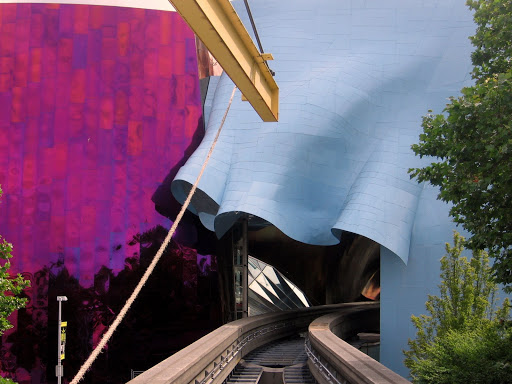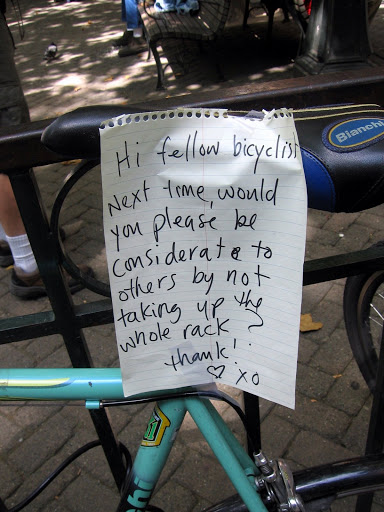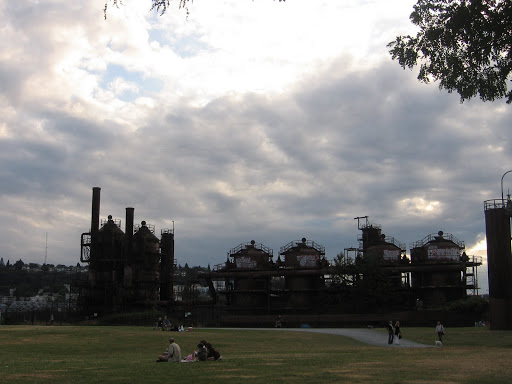Roosevelt Island is a narrow sliver of land in New York's East River, approximately forty city blocks in length, running parallel to Manhattan like some kind of growth-stunted sibling. The effect achieved is that of a quiet community of residences and hospitals with a dense photoshopped backdrop of buzzing skyscrapers. Once known more colorfully as Blackwell's Island, the land was used as a prison until usurped by Riker's in 1935. Notable "guests" over the years include William "Boss" Tweed, wizened anarchist Emma Goldman, drug-addled Billie Holiday, and racketeer Dutch Schultz. Mae West even shacked up for a week on (what else but) obscenity charges.

There are three means of reaching the island, aside from swimming. The Roosevelt Island Tramway, which opened in 1976, was originally intended to be a temporary transport until the much-delayed subway station was finished. However the tram caught on as an iconic tourist attraction and as a result continued operating after the subway station finally opened in 1989. There is also a bridge for automobiles which connects with Astoria, Queens.

Sidling up to the Queensborough (aka 59th Street) Bridge.

An approaching tram.

The Roosevelt Island terminus.


The 59th St Bridge (Feelin' Groovy).



At the southern tip of the island are the remains of the Smallpox Hospital, built in 1856 in a Gothic Revival style. Once abandoned it became known as the "Renwick Ruin," after its architect, James Renwick, Jr, who also fathered St Patrick's Cathedral and the Smithsonian Institution Building.





The aptly-named Octagon Tower, built in 1839, is a former lunatic asylum. A visiting Charles Dickens reported on its "lounging, listless, madhouse air." Undercover journalist Nellie Bly gained admittance by feigning insanity. Once released she wrote extensively of the dismal conditions. In recent years the Octagon was converted into residential apartments.

Lighthouse Park at the northern tip of the island.


Renwick was also responsible for the 50-foot Blackwell Island Light on the island's northern tip. This Gothic lighthouse was constructed from gray gneiss by convict labor to illuminate the dangerous waters of nearby Hell Gate.


The obstacle-free promenades that wind along the shore on either side of the island are hotspots for joggers and baby perambulators.

Downtown Main Street has a mildly unsettling atmosphere not unlike The Village from the surreal TV show The Prisoner. Each building sports identical red signs with identical white lettering. This includes the public library, a Roman Catholic church, and a senior citizens cultural center. The town flower shop is simply labeled "Flower Shop," and the nail salon, "Nail Salon."


Blackwell Park water fountain in front of Blackwell House, an 18th century farmhouse built by the great-grandson of the island's original namesake.







The Manhattan terminus.

Awaiting the next load of passengers.
17 September 2011
Blackwell's Island
16 September 2011
Gas Works Park
On a promontory jutting into Lake Union the Seattle Gas Light Company built a gasification plant to convert coal into gas. After fifty years of operation the plant shut down in 1956. Two decades later the land was opened as a public park. Rather than being demolished, the processing towers, boiler house, storage tanks, and various other machinery were left standing or converted into a children's play barn and picnic shelter. Political rallies, drum circles, kite flyings, chalk parties, candlelight vigils, solstice pageants, and film shootings are some of the goings-on that typically occur on the grounds.

06 September 2011
Victorian Flatbush
As early twentieth century New York crawled out from the remains of the Gilded Age, the gentry of noisy, polluted Manhattan longed for "a place in the country," as it were. Peaceful and isolated, yet conveniently located near a train for easy access to their banks and offices on weekdays. As a result, farmland in central Brooklyn was bought up and fitted with stately Victorian mansions. Today it would take quite a stretch of the imagination to consider Flatbush countryside, but many of the houses still remain in designated historical districts. The following photos were taken on Albemarle Road in the area known as Prospect Park South.









01 September 2011
A Day in Seattle

The iconic Space Needle.

An alien monster from Doctor Who.

"Mono means one. And rail means rail."

The monorail tracks plunge straight into the side of the EMP Museum.

The Smith Building, of Smith-Corona typewriter fame.


Pioneer Square.


A reservoir in Volunteer Park at the top of Capital Hill.


An unusual fountain in Cal Anderson Park.








Twice Sold Tales used bookshop.

The troll who lurks under the Aurora Bridge.


Skyline from the Bainbridge ferry.









